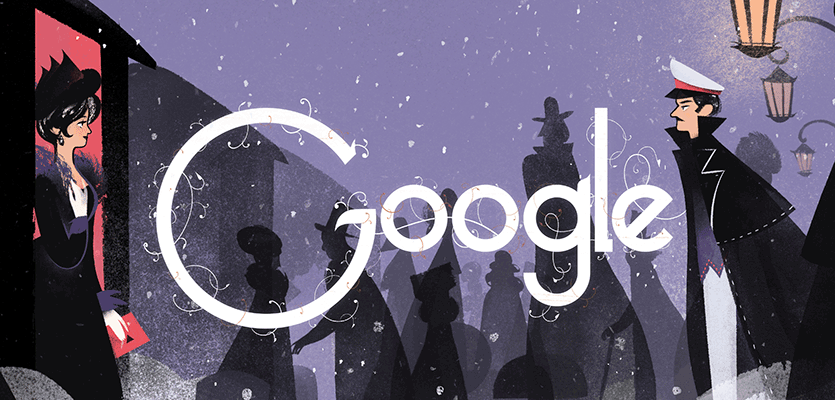
Sep 09, 2014
Leo Tolstoy's 186th Birthday
This Doodle’s Key Themes
I hardly need to say that making a tribute to Leo Tolstoy was a daunting task. No set of images can sum up a body of work so astonishing in scope, complexity, and vigor--its memorable scenes come to life with seeming effortlessness, fully realized in the immortal lines and between them. Tolstoy's lasting influence is a testament to the power of his art, which will remain relevant as long as the questions of life and death occupy our minds, which is to say – forever.
An early rough color sketch of the doodle's scenes. The second scene of War and Peace originally showed Andrei Bolkonsky in his carriage. After team feedback we opted to show Pierre Bezukhov and the comet instead.
Recently I designed and illustrated the Centennial Edition of James Joyce's Dubliners for Penguin Classics, which was a similarly challenging assignment. I felt that the only way to do justice to a book like Dubliners was to imitate some of the author's literary techniques in visual form. I froze the crowd on the cover between movement and paralysis, played with less obvious links between the stories, in short tried to evoke the atmosphere of the stories without giving away too much of the narrative or details.
A comparison of the digital sketch and the raw ink drawings for the second scene of The Death of Ivan Ilych.
For writers like Joyce and Tolstoy the imagery remains unique for each reader. Both authors are careful and selective with words, allowing the reader's imagination to collaborate with the text instead of passively taking it in. The language of cartooning, likewise, is the language of reduction; it's less descriptive than realistic artwork or film, and is less likely to replace the reader's vision. It seemed fitting to focus on Tolstoy's central theme of dualism and to highlight his stylistic nuances through the rhythm of the sequences – the almost full moon against the almost starless night, the red of Anna's handbag, Ivan's fatal curtains that stand between him and the light of his spiritual awakening.
Some of the original ink drawings for the Yasnaya Polyana forest and Kitty's hair, before being assembled digitally.
When I started rereading Tolstoy, it struck me how robust and modern his style is. The use of repetition, colloquialisms, and unorthodox syntax, as well as the extraordinary control over time and pacing are as potent and urgent as they were more than a century ago. In his Lectures on Russian Literature Vladimir Nabokov rather delightfully describes how Tolstoy "...unwraps the verbal parcel for its inner sense, he peels the apple of the phrase, he tries to say it one way, then a better way, he gropes, he stalls, he toys, he Tolstoys with words."
The color keys for the doodle.
The comet, disassembled.
The word "dom" (meaning both "house" and "home," just as "mir" in War and Peace means both "world" and "peace") appears on the opening page of Anna Karenina five times. The narrator's voice, at once invisible and distinctly Tolstoy's, shifts masterfully between the characters, allowing them to speak directly through minute detail, rhythm, and even occasional stream of consciousness, prefiguring the modernist techniques of the 20th century. In Anna Karenina's finest passages the narrator, the character, and the world are united in Tolstoy's seamless artistry.
A behind-the-scenes peek at how Anna Karenina was composed.
The stagelike format of the doodle seemed to lend itself perfectly for the chosen treatment, so the doodle team and I settled on two key images from the three major works. There's a myriad of scenes I'd outlined and sketched in the process, and I wish I could've include some of the lesser-known episodes, like Vronsky and Anna's encounter with the Russian painter in Italy, whose portrait of Anna is kept in the background of the narrative for hundreds of pages until it's seen again through Levin's eyes in one most striking scenes of the book.
The crowd visible in the background of the train station where Anna and Vronsky first encounter one another.
I sketched the chosen scenes digitally, then after a few revisions and adjustments went over them with brush and ink on layers and layers of paper. I then created a color scheme and assembled all these bits into digital layers that we arranged to move at varying speeds across the stage.
An earlier iteration of Tolstoy's portrait.
I hope the doodle will inspire viewers to discover and revisit these scenes in the way Tolstoy intended: through reading and rereading his timeless narratives.
Posted by Roman Muradov, guest doodler
Where this Doodle appeared
Discover more Doodles by color
Did you know?
The very first Doodle launched as an “out of office” message of sorts when company founders Larry and Sergey went on vacation.
Learn MoreDid you know?
The first Doodle launched in 1998, before Google was officially incorporated.
Learn MoreDid you know?
The first same day Doodle was created in 2009 when water was discovered on the moon.
Learn MoreDid you know?
Doodle for Google student contest winners have gone on to become professional artists
Learn MoreDid you know?
The time it takes from sketch to launch for a Doodle varies widely: some have taken years and others just a few hours!
Learn MoreDid you know?
Hundreds of Doodles launch around the world every year. Often, several different ones are live in different places at the same time!
Learn MoreDid you know?
Our most frequently recurring Doodle character is Momo the Cat - named after a real-life team pet!
Learn More